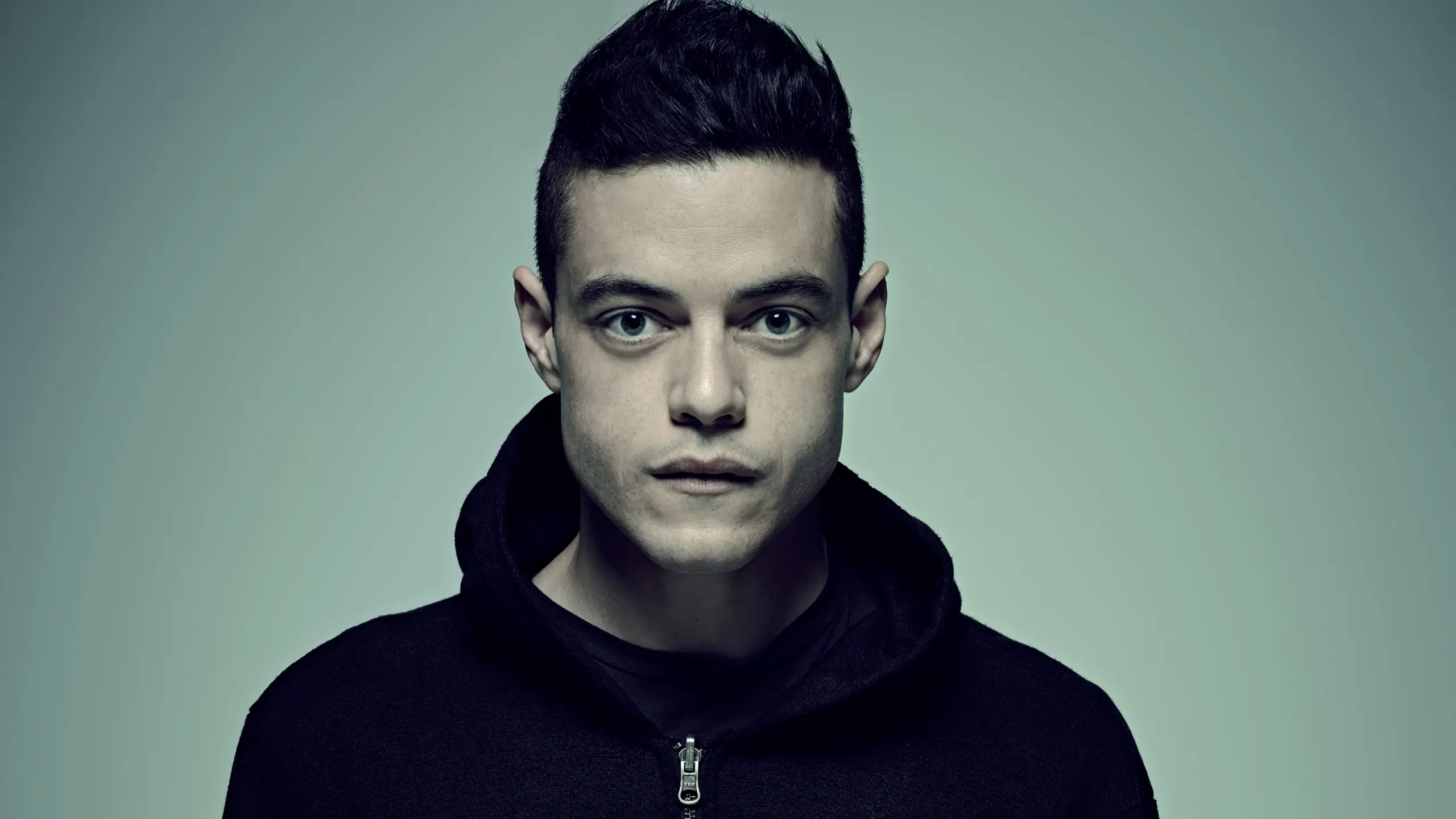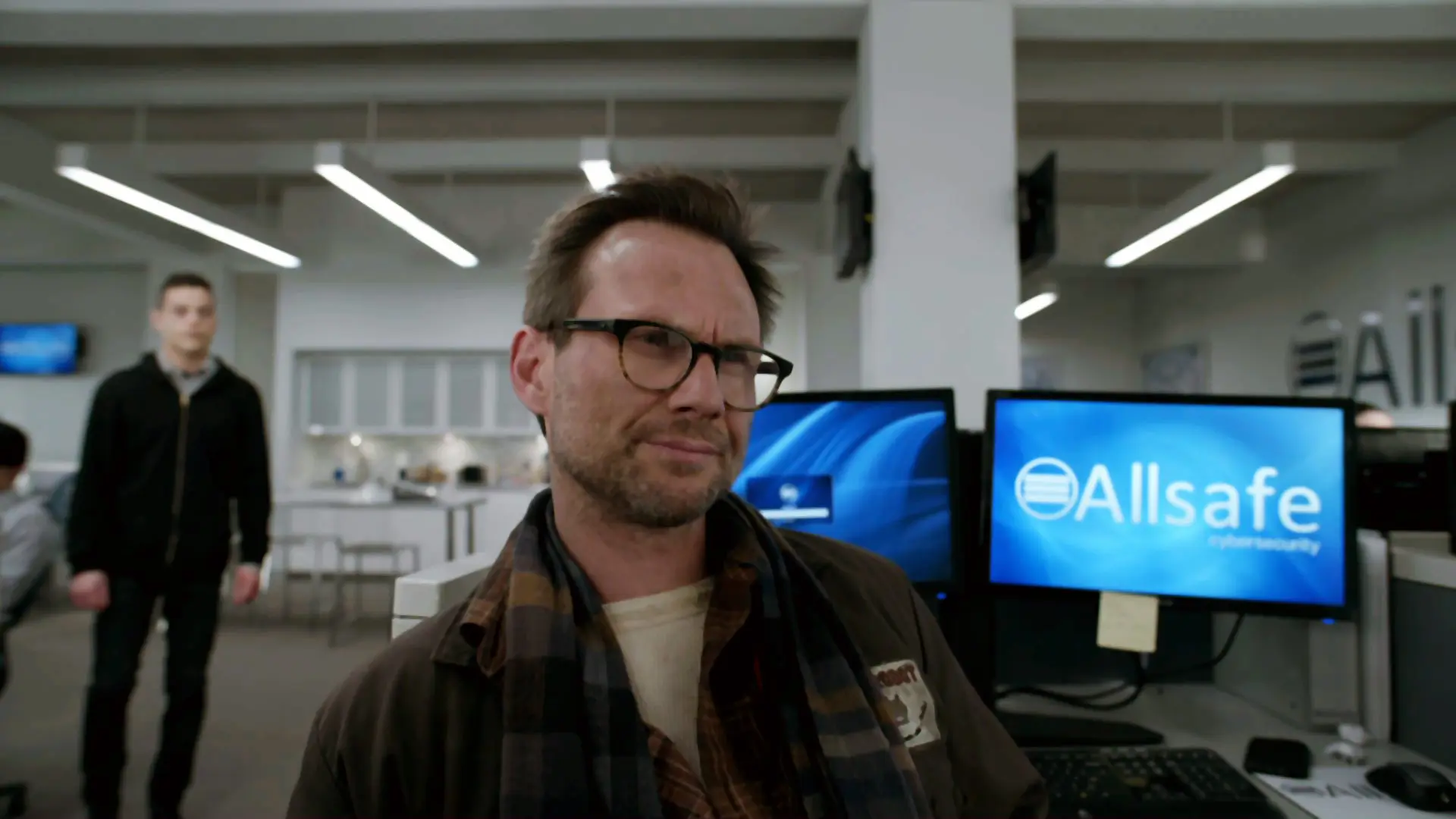MR. ROBOT Decoded: A Hero’s Death and the Fall of Democracy

Sam Esmail’s Mr. Robot can undoubtedly be called one of the most intellectually significant TV series aired in the 21st century.
The wealth of content presented by the creator and director of many episodes demands meticulous organization. Months have passed since the last episode premiered, yet there remains a lack of articles or recordings attempting to reconstruct the thought process behind this USA Network production. Although Mr. Robot tackles crucial topics such as geopolitics, the impact of technology on human life, the condition of postmodern society, the rise of China on the international stage, the decline of Western democracy, and even the breakdown of family structures and child sexual abuse, a silence still hangs over the title. While the first season attracted critics, and many texts were written about the show, interest drastically waned with the arrival of subsequent seasons. Esmail’s work deserves attention, and above all, a thorough analysis.

I
Let’s begin with the basics: on many levels, Sam Esmail seeks to disrupt the audience’s habits, redefining the experience of art. It is commonly believed that what the consumer reads/hears/watches is happening “for real,” i.e., it reflects the world portrayed. If we see a character walking forward, it means that’s what is happening. If a man tells a woman he loves her, he may not necessarily mean it, but it does mean that he is speaking to her. This assumption relates to an unspoken rule, a kind of contract between the creator and the audience. Under this pact, the author promises to present a certain vision of events in good faith. They want to “immerse” the audience in the created world, so they must be credible—after all, the author aims to discuss significant issues and highlight important aspects of human experience from their perspective. We don’t like being lied to.
In art, there are two dominant forms of narration, which can naturally intertwine: third-person and first-person. In the former, the camera or narrator remains above the events, looking from the outside like a witness, usually merely reporting and rarely commenting on the unfolding perils. Of course, the perspective is never entirely objective, as it reflects the worldview or aesthetic preferences of the creators. For example, a ballroom scene can be depicted through third-person narration in various ways. The camera may focus on the smiles of dancing couples, freely flowing with their steps, or it could focus on the gossiping onlookers around the dance floor, thereby emphasizing the hypocrisy of the gathered society members. A single event can be presented in numerous ways, with the creator’s intention being paramount in each case.

Alternatively, one can use a mediator—a character-narrator who describes the experienced adventures and emotional states in the first person. In this case, it’s not a detached observer or an author hiding behind omnipotent distance, but the protagonist who leads the audience through the labyrinth of the portrayed world. Many forget that what is presented isn’t necessarily what is happening; it’s filtered through the personality of the narrator. In other words, interpretation occurs at a fundamental level before words and images even reach the consumer of the artwork. The imagined world is then layered with the first-person narrator’s imagination and experience. Yet, even here, it’s assumed that the process is done in good faith, as mentioned before. The creator aims to delve deeper into the psyche of the character, who, for some reason, is more important than the rest. Adopting a subjective point of view doesn’t destroy the trust between creator and audience.
Elliot Alderson (Rami Malek), the protagonist of Mr. Robot, quickly establishes a connection with potential viewers. In the first scene, he breaks the fourth wall by directly addressing the audience. “Hello, friend” is like shaking hands—together, we will navigate the rotten reality alongside Elliot, rooting for him in his fight to regain control of his life. Though control is an illusion, it’s better to manage that illusion oneself than to relinquish it to a powerful corporation like E-Corp.

The opening of the story, the first few minutes of the first episode, sets the tone for the entire series. A young hacker with many social anxieties wages war against enemies of democracy. Recognizing the trap people have been caught in, he tries to free them from the invisible but dominant hand of capitalism and the destructive influence of technology, especially the Internet. By day, he’s a cybersecurity expert; by night, a superhero fighting evil. He soothes his shattered nerves with drugs, struggles with loneliness, but gives himself to the world. He wants to ascend to Olympus and dethrone the self-proclaimed gods. In his Promethean battle, he is supported by his sister Darlene (Carly Chaikin) and the titular Mr. Robot (Christian Slater), who leads the mysterious fsociety organization.
Over time, it becomes clear that Elliot cannot be trusted. He doesn’t remember events from the past, fails to recognize his sister, and most importantly, doesn’t realize that Mr. Robot, who accompanies him, is an invisible part of his personality that sometimes takes control. We learn that viewers have been watching Elliot in two versions: the anxious hacker hiding under a black hoodie, and the persona of his deceased father, dressed in a worn-out jacket and cap, reacting aggressively to events. Though Elliot is the mastermind behind the operation to destroy E-Corp, the other side of his psyche fuels his anger and steers him in the right direction.

There are even moments when the narrator deliberately misleads us. Despite being his “friends,” for much of the second season, Elliot hides the fact that he deliberately went to prison. In his imagination, he changes the scenery—a prison cell becomes a room in his family home, a prison guard transforms into his quiet, stern mother—because he doesn’t want to frighten us. He cares for us, but in a twisted way. He lies, but in good faith. He values our presence but doesn’t think we should immediately experience the same emotions as him. Elliot needs an audience for his actions; without it, he’s even more alone. Without it, he doesn’t exist.
II
Sam Esmail employs an interesting narrative tactic by constantly diverting the viewer’s attention away from what’s truly important. After watching the final episode, it’s clear that the most important storyline is the protagonist’s fragmented psyche, striving for healing through synthesis. The various personas represent different elements of Elliot’s life, but ultimately, it’s about saving his true self from ruin. The showrunner plays on two levels: he tries to present the political side of the TV spectacle as realistically as possible, yet there’s a lingering sense that the entire plot is merely a pretext for constructing the protagonist’s journey—from psychological fragmentation to integration, as he comes to terms with childhood trauma.

Whether we focus on the series’ realistic aspects or treat Mr. Robot as a Freudian hypnerotomachia or a mythical hero’s journey toward inner healing, Esmail consistently tries to distance the viewer from what’s key. This is best exemplified by the fifth episode of the third season, where a spectacular heist at E-Corp’s headquarters is portrayed as a continuous master shot. The camera work is mesmerizing, the pace of the action breathtaking, and the audacity of the attack on one of the most crucial institutions of social order is astonishing. The heist is the focus of the episode, yet the most important events take place elsewhere, only glimpsed on monitors in the building. At the same time, the UN is voting to grant China the right to annex Congo.
This is significant: we’re talking about a historic event. A state behemoth claims the right to purchase another country, as if territorial sovereignty could be bought and sold like real estate. Yet viewers aren’t allowed to delve deeper into this revolution because another form of revolt, far more spectacular and satisfying to social expectations, is being narrated. Who cares about Congo when a cyber leviathan is falling? Eventually, we learn that some of the spontaneously reacting crowd members are mercenaries from the Dark Army, whose sole purpose is to sow chaos. While the audience is more interested in the “epic” destruction at E-Corp, the real revolution always happens behind closed doors, where the powerful divide the spoils.

By diverting attention, the showrunner highlights the power of narrative in today’s world. Authority doesn’t lie with those who hold the truth or even money (though it helps); power belongs to those who control the narrative. Whoever can tell the story controls the people.
III
It’s possible that distraction is also a consequence of the consumer choices we make daily in our engagement with cultural goods. Taking certain topics seriously has become outdated, and it’s increasingly difficult to find creators who bypass the superficiality of pop culture, abandoning the familiar web of references in favor of tackling more timeless texts. Esmail also plays with these references—how many can, hand on heart, say they fully understand the reference to Tolstoy’s Resurrection? Who laughed at Leon’s monologue comparing Frasier to Knight Rider or recognized the reference to Vonnegut’s prose? I won’t even mention Lolita by Nabokov, as it was adapted by Stanley Kubrick, immortalizing the image of an exploited young girl hiding behind her iconic dark glasses, much like the frames worn by Darlene. Some titles, however, have irretrievably faded into oblivion, becoming unrecognizable relics of the past, forcing creators to rely on overplayed motifs and references to ensure their narrative remains accessible to audiences. Incidentally, Leon’s character, moving almost above the plot, serves as a near-authorial commentary of a “boomer” lamenting the decline of readership and cultural knowledge among peers. A stoned dude, an archetypal friend from the neighborhood bench, rambles on about Seinfeld and Three Days of the Condor, only occasionally engaging with what’s happening around him. His monologues emphasize the fictional nature of the presented world. Even his final line—“See you in the next episode”—suggests that he’s aware of existing within a simulation imagined by an invisible creator. He is merely a tool in the hands of a demiurge.

Returning to the main theme—the diverging plotlines, the multi-layered intersections of topics, correspond to the characters’ inner states. The rules governing the labyrinth of the world are incomprehensible, as it’s hard to maintain focus on anything for long. This issue was brilliantly described earlier by Kenneth J. Gergen in The Saturated Self: Dilemmas of Identity in Contemporary Life. Gergen provides a detailed analysis of the inner state of the postmodern individual entangled in so many conflicting relationships and expected to take on so many contradictory roles that, at some point, the self disintegrates, splitting into, for example, the Father-Self, the Worker-Self, and the Lover-Self. Scattered attention, fueled by stimuli from the external world, makes it difficult to reconnect the fragments of one’s personality, which negatively impacts the individual. In the long run, it’s impossible to juggle these masks with full commitment, leading to a superficial life, a sense of drifting on the surface of events rather than deeply immersing oneself in the experience of existence. Moreover, this fragmentation of the self leads to two significant consequences. The modern world demands perfection in every role, so the imperfection of the artificially constructed persona affects self-esteem. In other words, mistakes at work often lead to self-hatred, as one may start believing they are flawed, empty, and in need of constant improvement. Instead of one emptiness at the core of the personality, countless voids emerge, touching the fragmented personas—because it’s impossible to excel at everything. These experiences, in turn, reinforce the individual’s sense of weakness, deepening the wounds suffered by the true self. To cover these wounds, there arises a narcissistic need to prove one’s uniqueness. Weakness is often masked by addictions or fantasies because they can quickly hide anxieties. Simultaneously, since a person must be perfect in every possible domain, they must constantly multitask, focusing on several duties simultaneously. It’s no longer possible in today’s world to perform a single task without feeling that something vital is slipping away.

One must also remember the fundamental mechanism underlying postmodern reality. Due to the expansion of digital media, people are literally flooded with information. As media do not distinguish between more and less important facts before presenting a narrative, the recipient feels overwhelmed by the torrent of history. The exploitation of striking phrases to describe trivial events, with SHOCKING HEADLINES written in capital letters about the verbal slips of unknown celebrities, accompanied by EXCLUSIVE PHOTOS, creates a lack of vocabulary to describe experienced reality. The world today is simply too large to fully grasp, and the language to describe it has been exhausted.
This brings us back to Mr. Robot, where Esmail blends everything with everything—hacker revolutions with family drama, political warfare with a personal battle for self-determination in love. He foregrounds the most exciting themes of social unrest against corporate monopoly while weaving more personal and significant plotlines for the protagonist in the background. It’s akin to the fsociety members wearing masks—on-screen, we see only roles and grand words, but behind the scenes, a bloody game unfolds between the Chinese minister and the declining American hegemon.

The intricate plot is built on a basic premise familiar to an increasing number of people in the Western world. It turns out that in such complex times—due to politics, economics, or simply technology upending our existence—people seek the simplest solutions. Simultaneously, a quick glance at Facebook groups suggests that many don’t believe politicians simply make mistakes. If an important figure’s decision leads to a stock market crash, it was likely intentional, driven by hidden interests. If vaccines aren’t fully effective, it’s not because certainty and infallibility are hard to come by in life—it’s probably a malicious pharmaceutical company damaging its products because a healthy patient means losing a customer. In Mr. Robot, this kind of thinking organizes the entire presented world. According to Elliot, people would be much happier if they hadn’t been enslaved, and this enslavement happened due to a conspiracy by the wealthiest—the infamous one percent. The fight begins with a hacker attack on E-Corp, only to reveal that behind it all is the mysterious Whiterose and her Deus group.
The paranoid nature of the show manifests in its structure, comparable to a matryoshka doll. Each layer hides another, sometimes signifying the opposite of the surface layer. Initially, the protagonist believes that canceling citizen debt will bring about social justice, but it soon turns out that this only accelerated the corporate takeover of society, and in the end, Elliot joins the very corporation he despised to save it. White becomes black, and black becomes white. In the aforementioned fifth episode of the third season, during the “big heist” on E-Corp, Elliot meets Angela, his childhood friend and great love. He wants to prevent a catastrophe, while she collaborates with the Dark Army, seeking revenge for her mother’s death, likely caused by E-Corp’s machinations. He wears black, she wears white; he wants to bring order, she seeks destabilization. Who do we believe, who do we root for?

